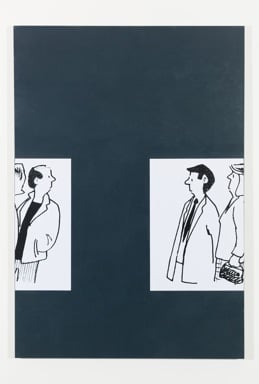Art & Exhibitions
Artist in the News: British Painter Oliver Osborne
While the meticulously painted rubber plants and collaged cartoons have already become his signature—the subtlety of Osborne’s work lies in the interplay between them.

While the meticulously painted rubber plants and collaged cartoons have already become his signature—the subtlety of Osborne’s work lies in the interplay between them.

Coline Milliard

Oliver Osborne is one of those rare painters whose work affects viewers on both a formal and conceptual level. Confident and knowingly humorous, his often ambitiously sized compositions weave a network of connections between abstraction, found images, and photorealism.
Yet if the melding of these three artistic modes is immediately recognizable—the meticulously painted rubber plants and collaged cartoons have already become a bit of a signature—the subtlety of Osborne’s work lies in the interplay between them.
“Abstraction is treated like a found image, or maybe a representational image of abstraction, and similarly the figurative paintings are kind of abstract in the very dry, or very still, way in which I paint them, says the artist.”
For all their tongue-in-cheek attitude, Osborne’s paintings tackle some of the core issues of his medium, probing and testing the way collage can engage on a physical and intellectual level. His cartoons, all borrowed from old European language textbooks, place communication under scrutiny. These overtly banal images are the drawn counterpart to Getty stock pictures or, as the artist points out, a sort of proto-clipart. They are simultaneously familiar enough to be easy to relate to–we can almost place the words into the speech bubbles Osborne empties out–and malleable enough to be applicable to a wide array of situations. But the artist throws viewers off the scent by altering the images, rendering them “mute, deadpan, still,” he says. Communication is both promised and denied.
In many ways, these collages function like the oilcloth in Picasso’s seminal Still Life with Chair Caning (1912). They unsettle the fabricated purity of the picture plane, polluting Osborne’s (post-post-)modern monochromes. They also harken back to the early days of Pop and its license to fuse high and low sources. Yet Osborne’s collisions are very much of our time, inscribed in the digital age of Google Images’ flat, algorithmic taxonomies. Once again, though, Osborne doesn’t surrender completely to a fixed referential framework. His disconcertingly subdued palette, with its yellowy greens and greyish blues, defy today’s bright, screen-ready aesthetic. They slip away, resisting Frank Stella’s “as good as in the can” ethos, revealing and reveling in the craftsmanship of color mixing. Making a “monochrome that wouldn’t be successful on an iPhone” would be a great achievement, Osborne muses.
Nevertheless, word has gotten out. The last two years have seen his paintings crop up in shows in Los Angeles (at the Mihai Nicodim Gallery), Berlin, Paris, and London (at the East End mainstay The Approach). Things began to accelerate further last summer, when the hip London gallery Vilma Gold took him under its wing. It plans on showcasing Osborne’s work in a solo presentation at the Independent art fair in New York the first week of March. Expect collaged monochromes and the introduction of an intriguing female head, adding to Osborne’s deftly staged confusion of genres.
Bio: Born 1985, Edinburgh; Lives and works in London. Chelsea College of Art and Design, 2008 Royal Academy Schools, 2011. Represented by Vilma Gold (London) and Frutta (Rome)
See it at: Vilma Gold at Independent New York, March 6–9, 2014